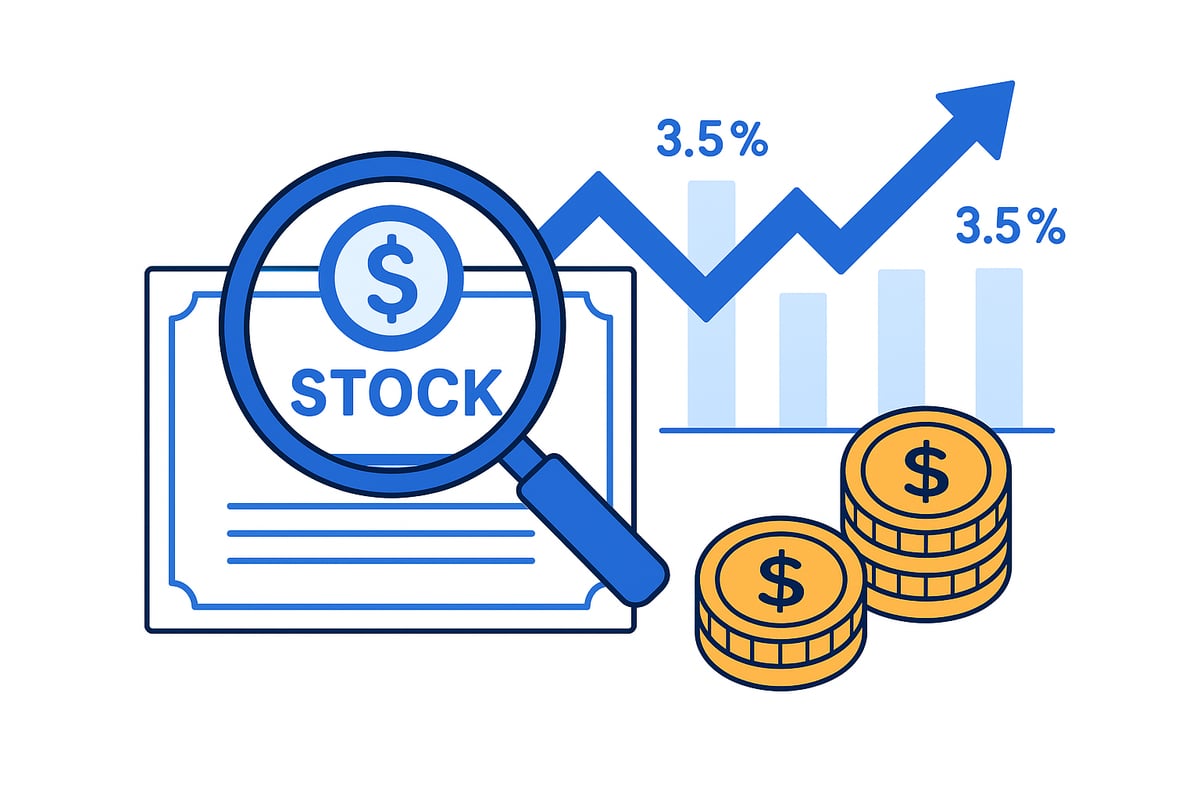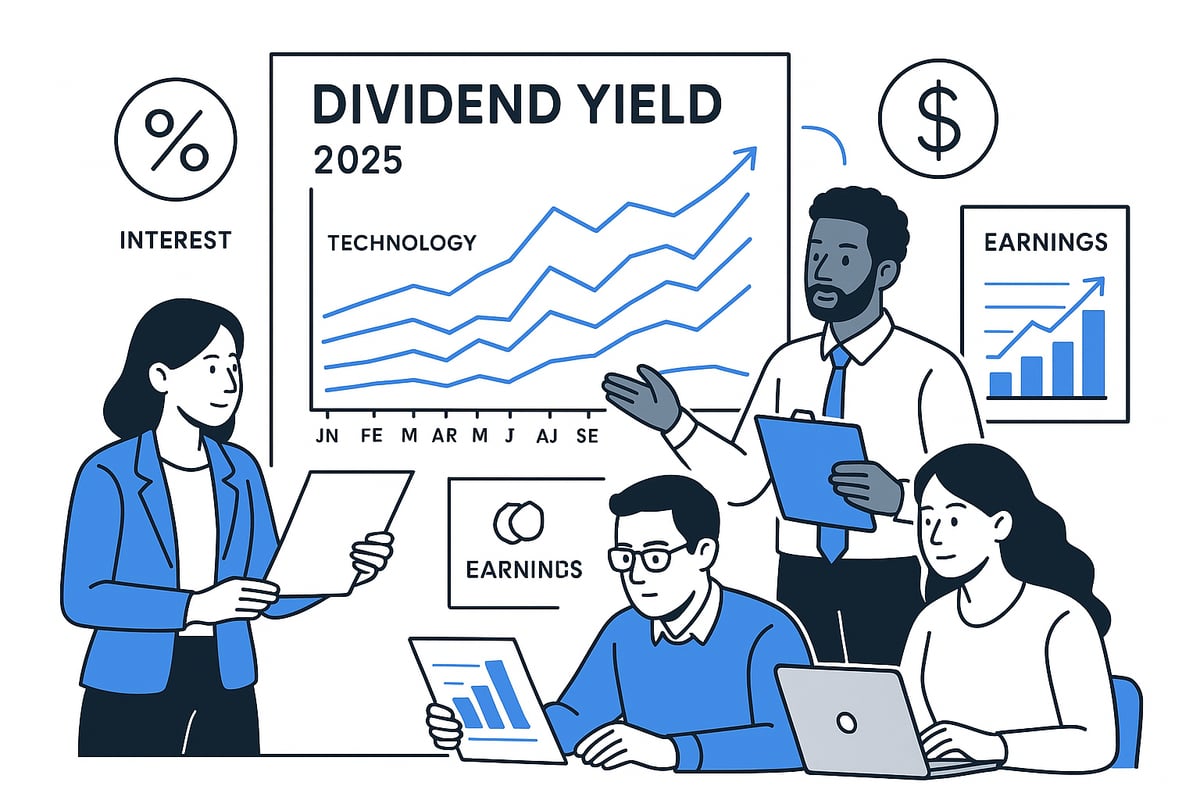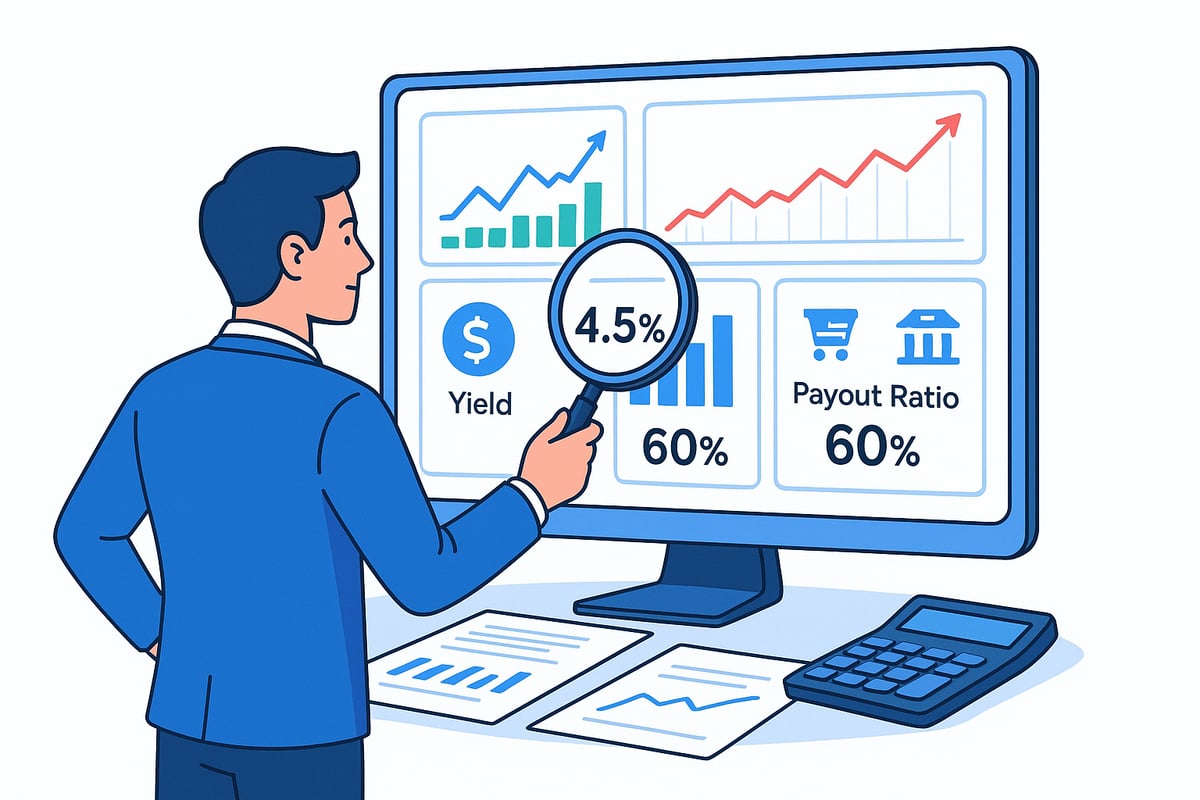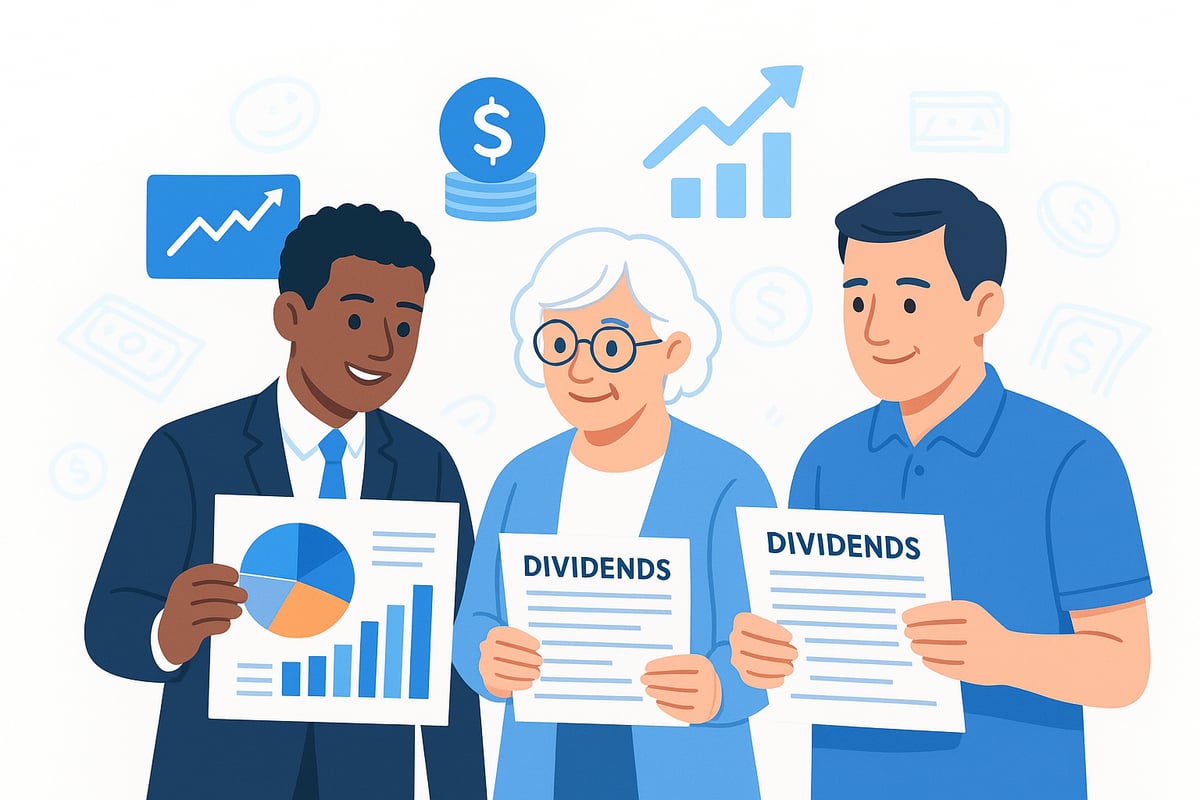Dividend Yield Guide: Expert Insights for Investors 2025
Imagine earning a steady stream of income from your investments, even when markets are unpredictable. As more investors turn to income-focused strategies, understanding dividend yield has become essential for building resilient portfolios. This guide breaks down dividend yield, offering clear explanations, expert insights, and actionable steps tailored for 2025. You will discover how to evaluate, compare, and leverage dividend yield to boost returns and achieve financial stability. Ready to take control of your investment future? Dive in and learn how these proven strategies can help you make smarter decisions in a changing market.
Understanding Dividend Yield: The Foundation for Income Investing
Grasping the basics of dividend yield is essential for any investor seeking steady income and long-term growth. This section lays the groundwork, breaking down what dividend yield means, how it is calculated, the different types, and why it is especially relevant in 2025.

What Is Dividend Yield?
Dividend yield is a financial ratio that shows how much a company pays out in dividends each year relative to its stock price. It is a key measure for income-focused investors, as it reveals the annual income generated per dollar invested.
Unlike the dividend payout ratio, which compares dividends to company earnings, dividend yield focuses on the return for shareholders based on the current stock price. For a deeper dive into this distinction, see Understanding payout ratios.
For example, if Stock A offers a 3% dividend yield while Stock B offers 1%, Stock A provides more income per invested dollar. For those prioritizing regular cash flow, dividend yield is a cornerstone metric.
The Dividend Yield Formula Explained
The formula for dividend yield is straightforward:
Dividend Yield = Annual Dividend per Share / Current Share Price
If a company pays $2 per share annually and trades at $50, the dividend yield is 4%. This formula works for both quarterly and annual payouts, as long as you annualize the dividend.
Stock prices fluctuate daily, so dividend yield can change even if the dividend remains constant. Be cautious: sometimes a falling share price can make the dividend yield appear unusually high, which may signal risk rather than opportunity.
Types of Dividend Yields: Forward vs. Trailing
There are two main types of dividend yield: trailing and forward. Trailing yield looks at dividends paid over the past 12 months, offering a backward-looking perspective. Forward yield projects expected dividends for the next 12 months, based on company guidance or analyst estimates.
Trailing yield is useful for evaluating consistency, while forward yield helps investors estimate future income, especially with companies that regularly raise dividends. For instance, a company with a rising dividend policy may show a higher forward yield, signaling potential for increased income.
Why Dividend Yield Matters in 2025
In 2025, dividend yield is more important than ever due to higher interest rates, persistent inflation, and growing investor appetite for reliable income. Historically, high-yield stocks have provided stability during market volatility.
Data from the S&P 500 Dividend Aristocrats shows that companies with a strong dividend yield have often outperformed the broader market during uncertain times. For retirees and long-term investors, dividend yield serves as both a source of income and a sign of company health, as experts view stable yields as evidence of financial strength.
Key Factors Influencing Dividend Yield in 2025
Understanding the forces that shape dividend yield is essential for investors seeking stable income in 2025. Each of the following factors can significantly impact both current yields and future income potential. By analyzing these elements, investors can better position their portfolios for resilience and growth.

Interest Rates and the Macroeconomic Landscape
Interest rates are a primary driver of dividend yield for stocks. When rates rise, income-focused investors often compare yields from stocks to those from safer assets like bonds. In 2025, the Federal Reserve's policy direction and inflation projections will influence how attractive equity yields appear.
For example, if bond yields increase, investors may demand higher dividend yield from stocks to justify the added risk. Utilities and real estate investment trusts (REITs) are sectors particularly sensitive to these shifts, as their yields must stay competitive. The yield spread between stocks and bonds is a useful metric to watch.
According to the 2025 Dividend Stock Outlook, analysts expect continued focus on yield-generating stocks, especially if market volatility persists.
Company Fundamentals: Earnings, Payout Ratios, and Growth
A company's earnings stability is crucial to maintaining a reliable dividend yield. Companies with consistent profits are more likely to sustain or grow their payouts over time. The payout ratio, calculated as dividends divided by earnings, helps investors assess sustainability.
A payout ratio above 80 percent can signal risk, as the company may lack flexibility to weather downturns. Blue-chip stocks typically offer moderate dividend yield with lower risk, while speculative stocks may promise high yields but lack earnings support. Reviewing average S&P 500 payout ratio trends provides context for what is reasonable in the current environment.
Evaluating company fundamentals ensures the dividend yield is both attractive and sustainable.
Sector and Industry Trends
Certain sectors are known for delivering higher dividend yield, including utilities, energy, REITs, and financials. In 2025, sector rotation trends will play a key role. Some industries, like oil and gas, may offer rising yields as profits rebound, while technology often provides lower yields but higher growth.
Comparing sector average yields using data from Yahoo Finance helps investors identify where opportunities are shifting. For example, utilities may offer a 3.5 percent average yield, while technology lags at under 1 percent. Awareness of sector trends helps balance income and growth in a portfolio.
Company Dividend Policies and Recent Changes
Dividend policies, such as hikes, cuts, and suspensions, can alter dividend yield overnight. In 2023 and 2024, several companies either increased payouts to signal confidence or reduced dividends to preserve cash. Monitoring dividend announcement calendars helps investors anticipate changes and avoid surprises.
For instance, a company increasing its dividend may attract new investment and boost yield, while a sudden cut can erode both trust and share price. Understanding recent policy trends allows investors to gauge yield stability and adjust their strategies accordingly.
Market Volatility and Price Movements
Stock price fluctuations directly affect dividend yield. When prices drop, yield can appear artificially high, but this may signal a “dividend trap” if fundamentals are weak. In past crises like 2008 and 2020, many high-yielding stocks suffered as their share prices declined due to business challenges.
It is important to distinguish between genuine opportunities and risky situations. Reviewing historical examples, investors can see that sustainable dividend yield is built on strong business performance, not just high payouts. This awareness helps avoid common pitfalls in volatile markets.
How to Analyze and Compare Dividend Yields Like an Expert
Becoming adept at analyzing and comparing dividend yield empowers you to build a resilient, income-focused portfolio. With a disciplined approach, you can distinguish strong opportunities from risky outliers, ensuring your investments align with your goals and risk tolerance.

Beyond the Yield: Evaluating Dividend Quality
While a high dividend yield may catch your attention, it is not always a sign of a sound investment. True quality lies in the consistency and growth of dividend payments over time. Companies that reliably increase dividends, such as Dividend Aristocrats, often demonstrate strong financial health and commitment to shareholders.
Look for businesses with a track record of stable or rising dividends for at least ten years. Analyze dividend coverage ratios and free cash flow to ensure payouts are sustainable. Comparing a high-yield laggard to a steady grower can reveal which stock is more likely to provide lasting income and portfolio stability.
Tools and Metrics for Dividend Analysis
To go beyond surface-level dividend yield, use financial tools and metrics that highlight dividend sustainability. Key indicators include the payout ratio, which measures dividends as a percentage of earnings, and the dividend coverage ratio, which compares earnings or cash flow to dividend obligations.
Review a company's cash flow statement and income statement basics to determine if dividend payments are supported by actual profits. Screening tools like Yahoo Finance or CFI calculators can help you filter stocks with healthy payout ratios and consistent growth, minimizing the risk of unsustainable dividends.
Spotting Dividend Traps and Avoiding Pitfalls
Not all high dividend yield stocks are safe bets. Sometimes, a yield spike signals trouble, such as a falling share price or deteriorating business fundamentals. These so-called "dividend traps" can lure investors with the promise of income but often lead to losses if the company cuts its payout.
Watch for red flags like sudden drops in earnings, negative cash flow, or an unsustainable payout ratio above 80 percent. Reading dividend safety scores and reviewing recent dividend cuts across the market can help you steer clear of risky positions and protect your income stream.
Comparing Dividend Yields Across Sectors and Markets
Dividend yield varies widely by industry and geography. Utilities and REITs typically offer higher yields than technology or growth sectors. When comparing yields, always adjust expectations based on sector norms to avoid unfair comparisons.
International markets can provide attractive yields, but factors like currency risk and foreign withholding taxes must be considered. For example, US REITs may offer higher yields than European telecoms, but tax treatment and political risk can affect your net income. Always compare apples to apples for informed decisions.
Using Historical Context to Inform Yield Analysis
Reviewing historical market cycles can sharpen your dividend yield strategy. During downturns like the 2008 financial crisis or the 2020 pandemic, dividend-paying stocks often showed greater resilience than the broader market.
Track how companies performed during past recessions—those that maintained or grew dividends signal reliability and financial strength. Analyzing average yield changes and recovery timelines after market shocks equips you to anticipate challenges and identify stocks likely to weather future storms.
Dividend Yield Strategies for Different Investor Profiles
Successful income investing starts with a strategy that fits your goals, risk tolerance, and time horizon. Whether you are building your first portfolio or optimizing an established one, tailoring your approach to dividend yield can make a significant difference in long-term results.

Building a Dividend Portfolio: Step-by-Step Guide
Constructing a portfolio focused on dividend yield involves setting clear income and growth targets. Begin by outlining your desired yield, for example, aiming for 4% annual income. Next, diversify across sectors such as utilities, consumer staples, and financials to manage risk.
Use stock screeners to identify candidates with strong dividend yield, stable payout histories, and sound fundamentals. Rebalance periodically to maintain your target yield and adjust for market changes. For the latest strategies and stocks outperforming the market, see US Dividend Stocks Outpacing the Market in 2025.
Dividend Growth vs. High Yield: Which Is Right for You?
Choosing between a high dividend yield and dividend growth depends on your needs. Retirees may prefer high-yield stocks for immediate cash flow, while younger investors might opt for companies with growing dividends to maximize total return.
For example, Procter & Gamble offers steady dividend growth, while AT&T provides a higher, but less consistent, yield. Analyze your risk profile and investment horizon to determine the right balance. Over time, dividend growth can outpace inflation and increase your income stream.
Tax Considerations for Dividend Investors
Understanding how taxes affect your dividend yield is crucial. In 2025, qualified dividends may be taxed at lower rates, while non-qualified dividends face ordinary income tax. International investments might incur withholding taxes, reducing your net yield.
For instance, $10,000 in annual dividends could result in different after-tax amounts depending on the source and qualification. Stay updated on tax law changes and consider tax-advantaged accounts to optimize your dividend yield and income.
Using ETFs and Mutual Funds for Dividend Yield
Exchange-traded funds and mutual funds offer a simple way to access diversified dividend yield. Popular funds like the Vanguard Dividend Appreciation ETF (VIG) and iShares Select Dividend ETF (DVY) provide exposure to dozens of dividend-paying companies.
The main advantages include diversification and professional management, though fees and potential yield dilution can impact returns. Review fund holdings, expense ratios, and historical yield performance to ensure they align with your dividend yield objectives.
Reinvesting Dividends for Compounded Growth
Reinvesting dividends through a dividend reinvestment plan (DRIP) can significantly enhance your portfolio’s long-term growth. By automatically purchasing more shares, you tap into the power of compounding.
Consider this: $1,000 invested in a 4% dividend yield stock, with dividends reinvested, grows much faster over 10 years compared to taking cash payouts. Compounding accelerates your returns, making reinvestment a powerful tool for building wealth through dividend yield.
2025 Dividend Yield Trends and Market Outlook
Dividend yield strategies are evolving quickly as we move into 2025. Shifting economic conditions, sector rotations, and global market opportunities are shaping the landscape. Understanding the latest trends, risks, and expert forecasts is key for investors who want to optimize their income strategies and ensure long-term portfolio resilience.
Sectors and Stocks to Watch in 2025
In 2025, several sectors are positioned to offer compelling dividend yield opportunities. Utilities, energy, and real estate investment trusts (REITs) continue to lead for consistent payouts, especially as interest rates remain elevated. Analysts are also monitoring financials for potential yield growth as lending margins expand.
A recent update to the Dividend Aristocrats list highlights stocks like Procter & Gamble and Johnson & Johnson for their reliable dividend growth. Here is a snapshot of projected sector yields:
| Sector | Projected Yield (%) |
|---|---|
| Utilities | 3.7 |
| Energy | 4.2 |
| REITs | 3.5 |
| Financials | 2.8 |
| Consumer | 2.4 |
Investors should keep an eye on sectors with stable cash flows and a history of dividend increases, as these are most likely to sustain yield through changing market cycles.
Global Dividend Yield Opportunities
Looking beyond the US, global markets present attractive dividend yield prospects for 2025. Developed markets in Europe, such as the UK and Germany, often feature higher yields due to mature companies and shareholder-friendly policies. Emerging markets in Asia, including Singapore and Hong Kong, are also gaining attention for their robust banking and telecom dividends.
However, investing internationally introduces currency risks and varying tax treatments. For instance, European stocks may offer a 4.5% yield, but after currency fluctuations and taxes, the net income can differ significantly. Diversifying across regions helps balance these factors, allowing investors to capture opportunities without overexposing to single-country risks.
Risks and Headwinds for Dividend Investors in 2025
While dividend yield remains attractive, several risks could impact returns in 2025. Economic slowdowns may force companies to cut or suspend dividends, especially in cyclical sectors. Regulatory changes, such as new payout restrictions in financials, could also affect income streams. Inflation is another key concern, as it can erode the real value of dividends.
To navigate these challenges, investors should focus on companies with strong balance sheets and a track record of dividend resilience. For more on identifying safer stocks during periods of high interest rates, review the strategies in Dividend Resilience in High-Interest-Rate Environment.
Expert Forecasts and Analyst Insights
Leading analysts predict that dividend yield will continue to play a vital role in portfolio construction for 2025. The consensus is that S&P 500 yields will remain stable or slightly increase, as companies prioritize shareholder returns. Market strategists from CFI and Yahoo Finance point to sectors with healthy payout ratios and earnings growth as prime candidates for sustainable income.
According to recent research, there is even more room for dividend growth as corporate earnings recover and balance sheets strengthen. Investors are advised to monitor forward yield estimates and payout ratios, ensuring they align with long-term growth and income goals.
Incorporating Historical Market Context into 2025 Strategy
History shows that dividend yield strategies can provide stability during periods of market turbulence. For example, during the 2020 pandemic selloff, dividend-paying stocks demonstrated faster recovery and less volatility compared to non-dividend peers.
By studying past market cycles, investors can identify patterns in dividend growth and resilience. Understanding how yields responded during crises such as 2008 and 2020 helps inform smarter allocation decisions for 2025. Reliable dividend payers have historically delivered consistent income, making them a cornerstone of income-focused portfolios.
Practical Steps to Start or Optimize Your Dividend Yield Strategy
Ready to take action with your dividend yield strategy? Whether you are building a new portfolio or optimizing an existing one, a systematic approach is essential. The following steps will help you clarify your goals, identify the right opportunities, and adapt to changing market conditions for consistent income and growth.
Setting Investment Objectives and Yield Targets
Start by defining your investment objectives. Are you seeking steady income, long-term capital appreciation, or a blend of both? Establishing a clear goal will shape your dividend yield targets and portfolio construction.
Next, assess your risk tolerance. Conservative investors may prefer stable companies with moderate yields, while aggressive investors might pursue higher yields with more volatility. For example, a retiree might set a 4% dividend yield target to meet income needs, using tools like yield calculators to track progress.
Revisit these objectives regularly. As your life stage or market conditions change, your required yield and strategy may evolve.
Screening and Selecting Dividend Stocks
Effective screening is key to a successful dividend yield strategy. Use stock screeners to filter by yield percentage, payout ratio, and dividend growth history. Focus on companies with a sustainable yield, consistent payment records, and solid fundamentals.
Consider evaluating the Price to Earnings ratio explained, as it provides insight into valuation and complements dividend yield analysis. Typically, look for stocks with a yield above your target threshold and a reasonable payout ratio (below 70%).
Diversify across sectors and company sizes to reduce risk. Review each stock’s dividend policy, stability, and sector trends before making a decision.
Monitoring and Adjusting Your Portfolio
Once your portfolio is in place, continuous monitoring is crucial. Set up alerts for dividend announcements, changes, or cuts, as these can impact your dividend yield and income projections.
Rebalancing helps maintain your target yield and risk profile. If a company cuts its dividend or fundamentals weaken, consider replacing it with a more reliable alternative. Watch for signs like payout ratio spikes or declining earnings that could threaten future payouts.
Regular reviews ensure your portfolio stays aligned with your objectives and adapts to market shifts.
Staying Informed: Best Resources for Dividend Investors
Stay updated with reliable news sources, analyst reports, and financial data platforms to keep your dividend yield strategy effective. Use tools like Yahoo Finance for dividend calendars, alerts, and sector performance tracking.
Join investing communities and forums to exchange insights and learn from peers. Explore guides on related topics, such as the Small-cap stock definition, to broaden your understanding of diversification within dividend strategies.
Ongoing education and timely information help you make confident, well-informed decisions in a shifting market environment.
As you’ve seen throughout this guide, understanding dividend yield takes more than just crunching numbers—it’s about learning from the past to make smarter decisions for your future. If you’re excited to deepen your knowledge and explore how historical trends shape today’s market, you’re not alone. We’re building a platform designed to empower investors like you with interactive charts, AI-powered insights, and the rich context behind every market move. Want to help shape the future of financial research and get early access? Join Our Beta and see how looking back can help you stay ahead in 2025 and beyond.
